Abstract
1 The sympathetically-innervated hepatic arterial vascular bed of the dog was perfused from a femoral artery. Hepatic arterial blood flow and perfusion pressure were recorded continuously, and the hepatic arterial vascular resistance (HAVR) calculated from these measurements.
2 Intra-arterial injections of phenylephrine caused dose-dependent rises in HAVR, indicating hepatic arterial vasoconstriction, at all doses above threshold. No secondary reductions in HAVR followed these responses.
3 Intra-arterial injections of isoprenaline caused only dose-dependent reductions in HAVR at doses above threshold.
4 Intra-arterial injections of noradrenaline typically caused an initial increase in HAVR which was followed at all but the highest doses by a secondary, delayed, reduction in HAVR.
5 Intra-arterial injections of adrenaline, like those of noradrenaline, resulted in hepatic arterial vasoconstriction followed by hepatic arterial vasodilatation.
6 On a molar basis, the most potent hepatic arterial vasoconstrictor was noradrenaline, followed by adrenaline and phenylephrine.
7 The maximum reductions in HAVR caused by adrenaline (mean reduction = 21.9%) and noradrenaline (16.9%) were significantly smaller than those due to isoprenaline (P < 0.001).
8 Propranolol attenuated the hepatic arterial vasodilator responses due to isoprenaline, and the secondary falls in HAVR following intra-arterial adrenaline and noradrenaline.
9 Propranolol did not modify the vasoconstrictor responses to phenylephrine.
10 Both adrenaline and noradrenaline were more potent hepatic arterial vasoconstrictors after propranolol than in the absence of β-adrenoceptor blockade. The potentiation of the vasoconstrictor effects of adrenaline was statistically significant.
11 After propranolol, adrenaline was a more potent hepatic arterial vasoconstrictor than noradrenaline.
12 Since the β-adrenoceptors in the hepatic arterial vasculature were not blocked by atenolol, but were stimulated by salbutamol, it is concluded that they are predominantly of the β2-type.
13 The vasoconstrictor actions of phenylephrine, noradrenaline and adrenaline were all antagonized by the systemic administration of phentolamine, all three dose-response curves being shifted to the right.
14 The results are discussed with regard to the possible control of the hepatic arterial vasculature by naturally-occurring catecholamines.
Full text
PDF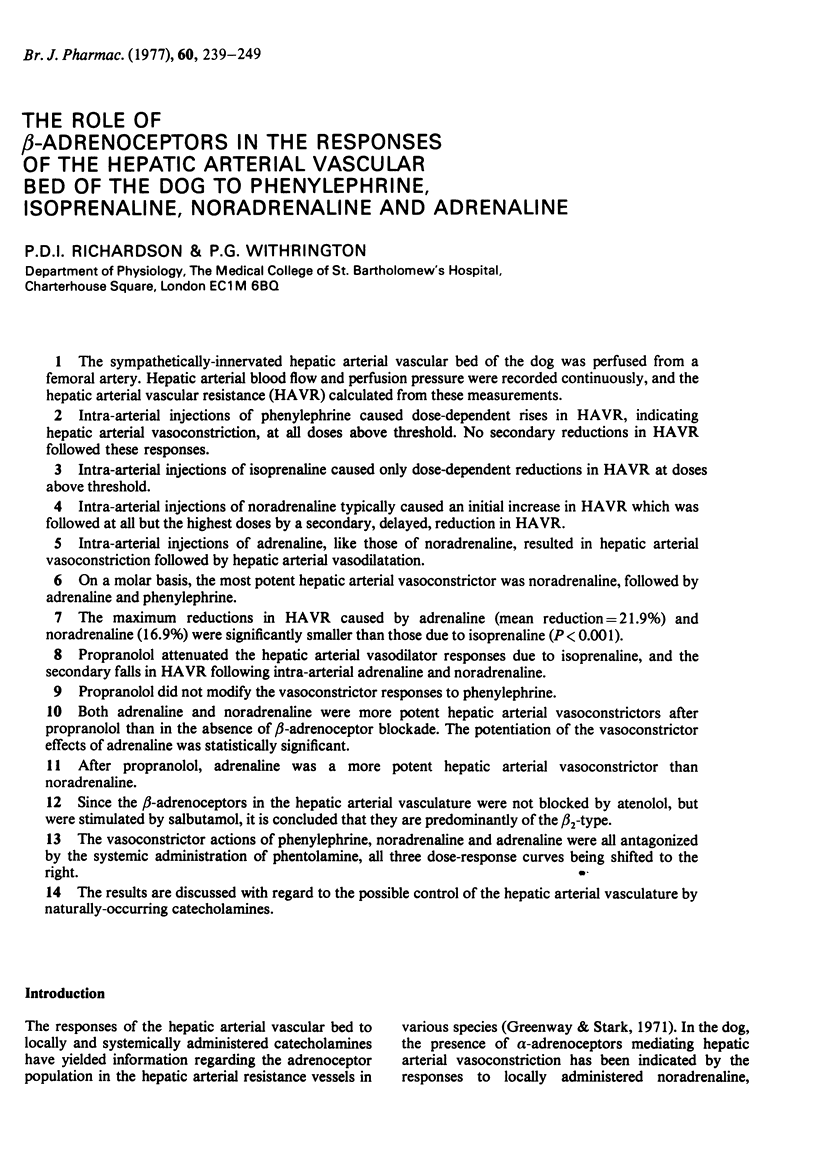
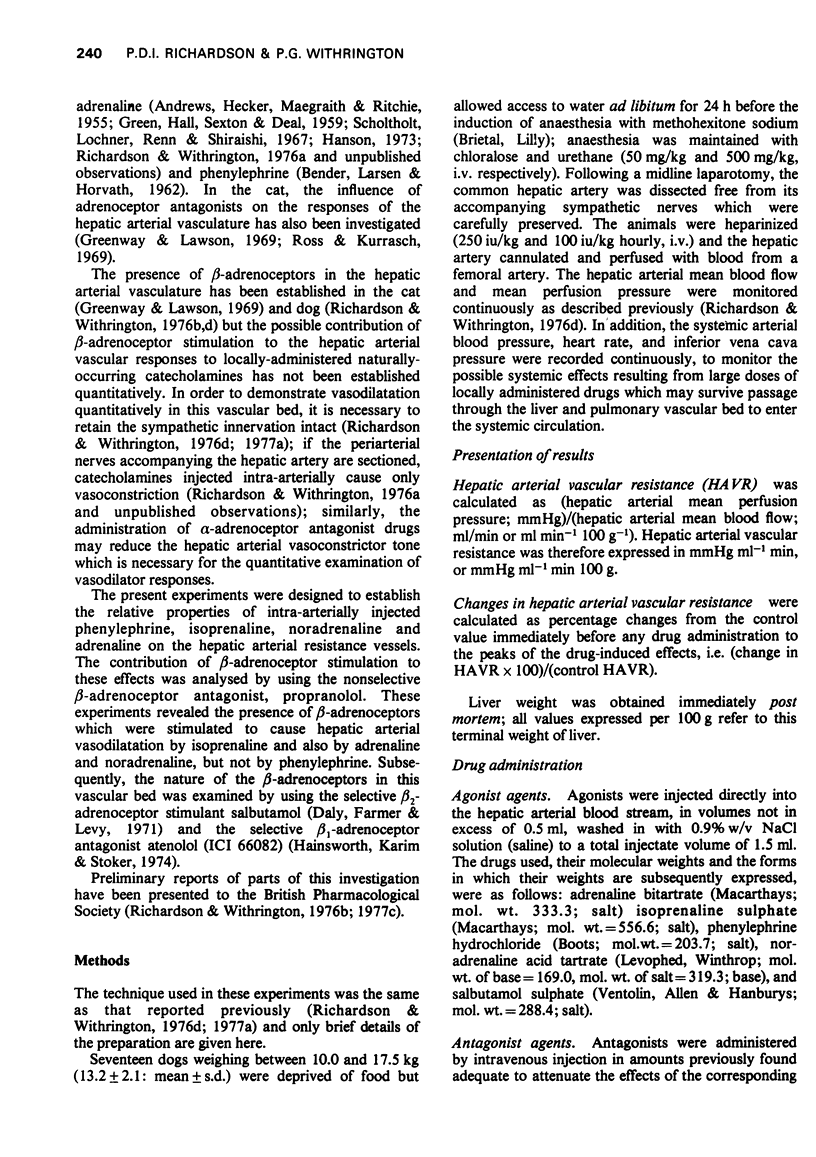
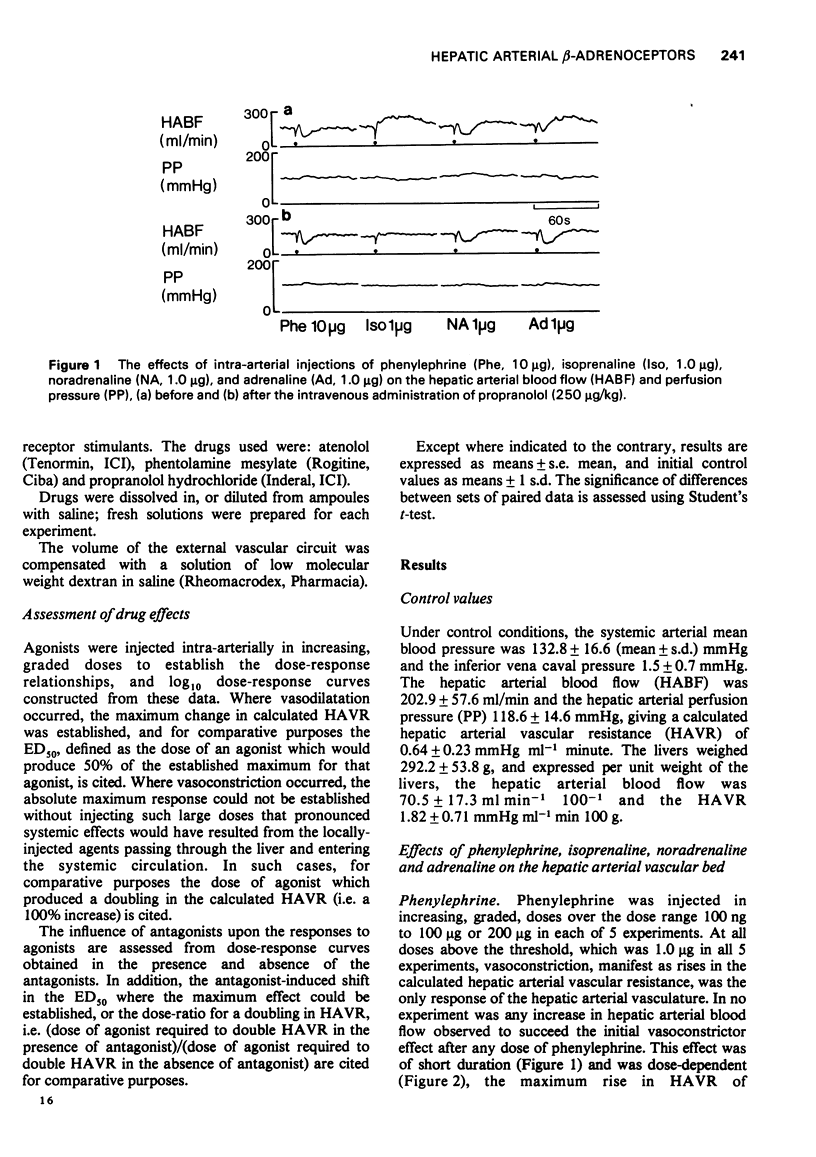
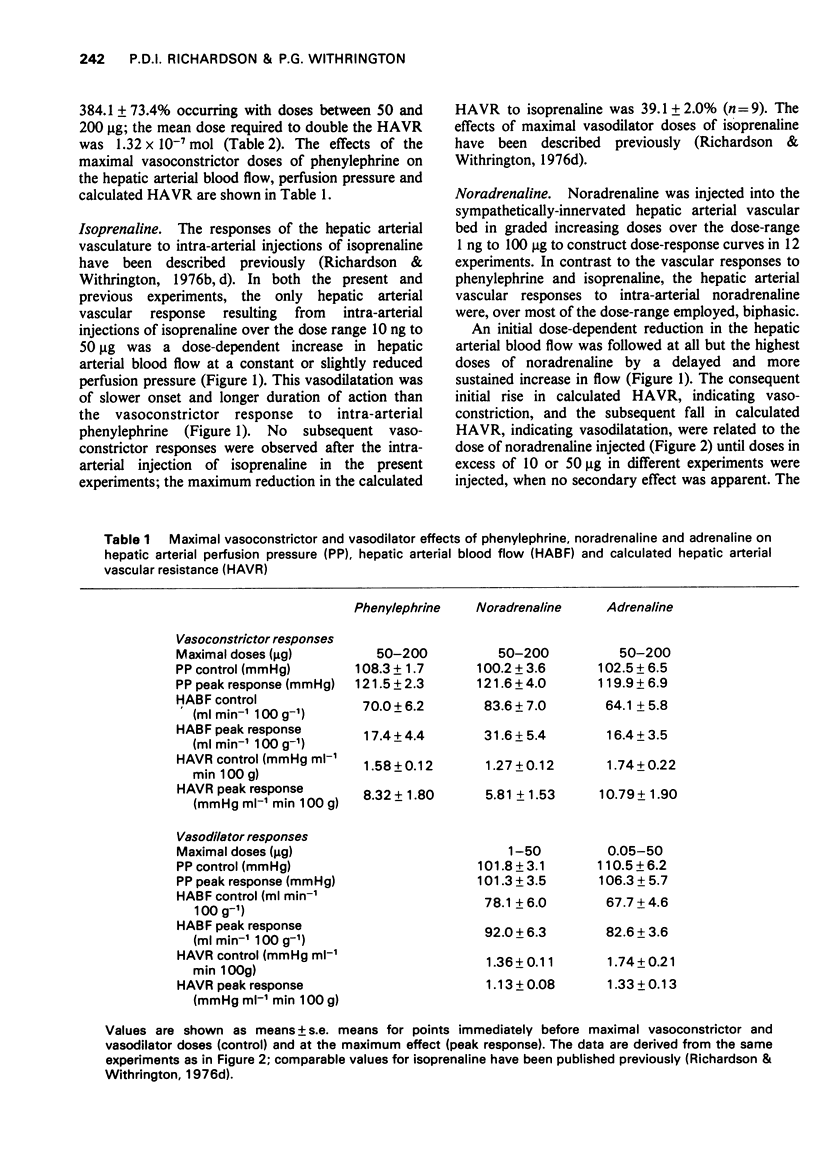
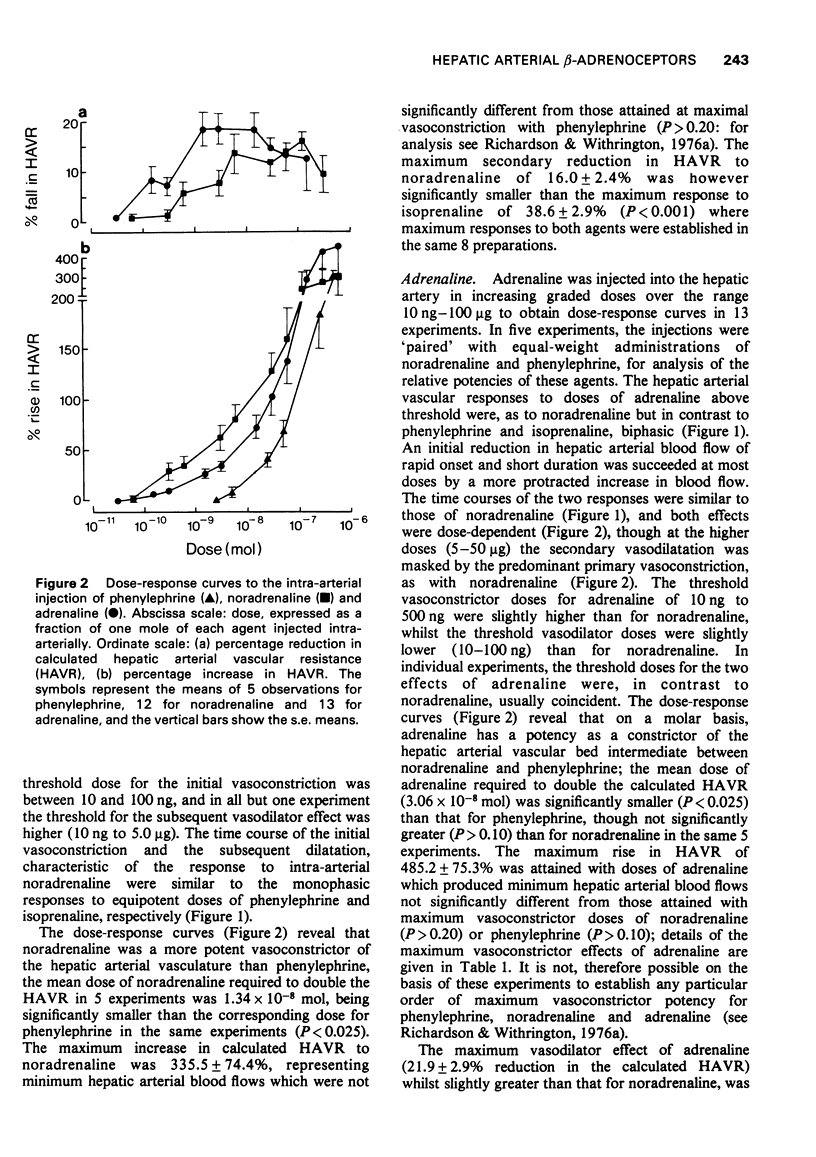
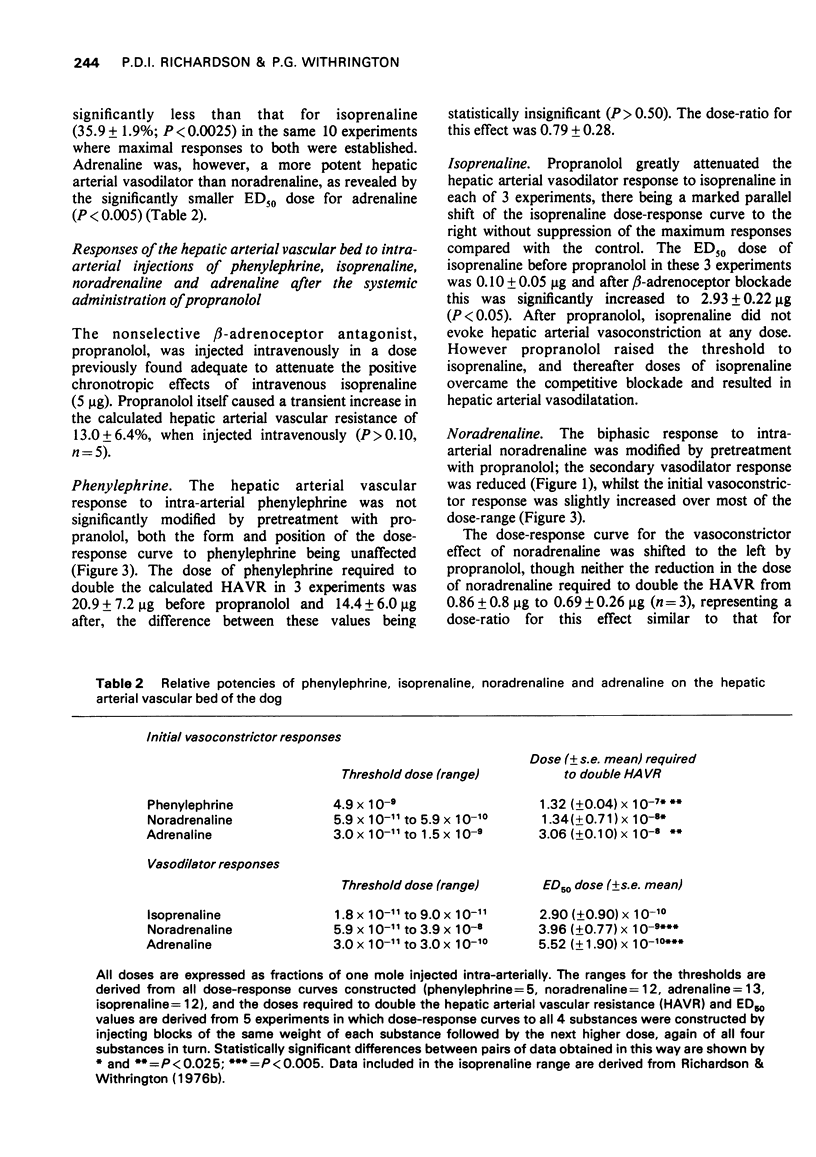
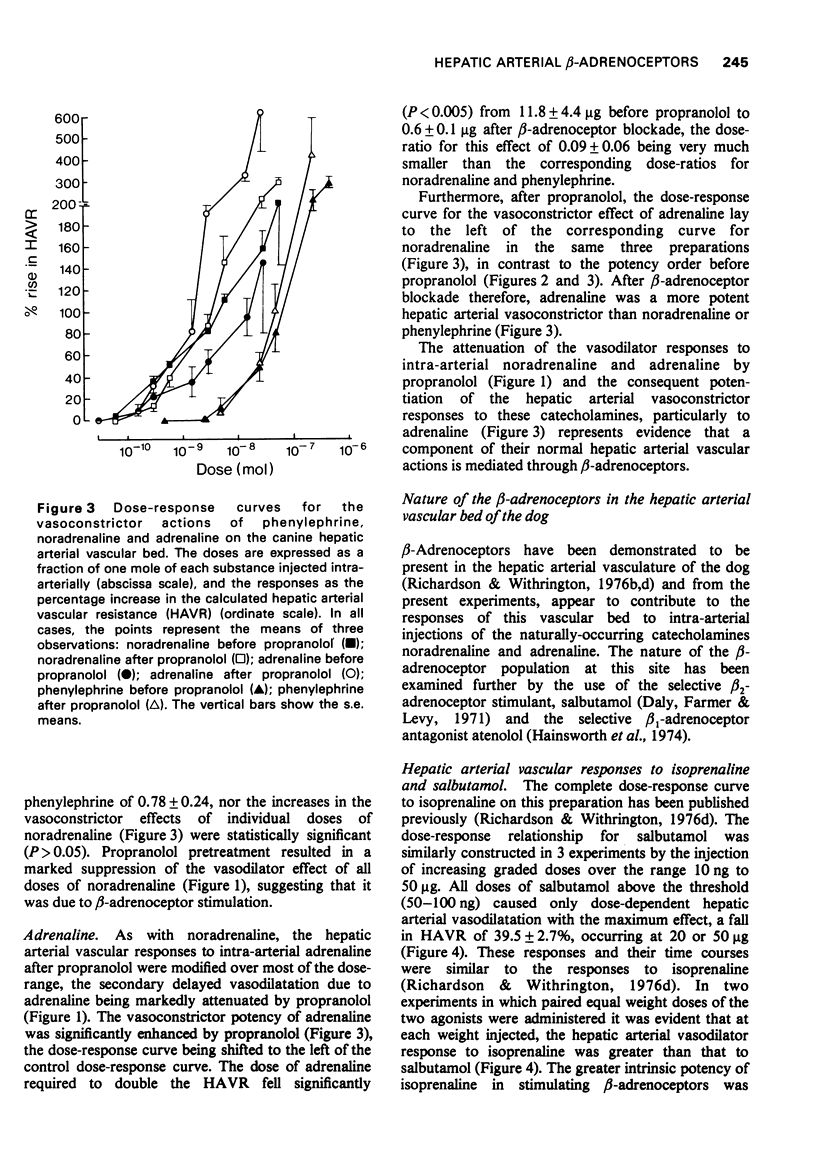
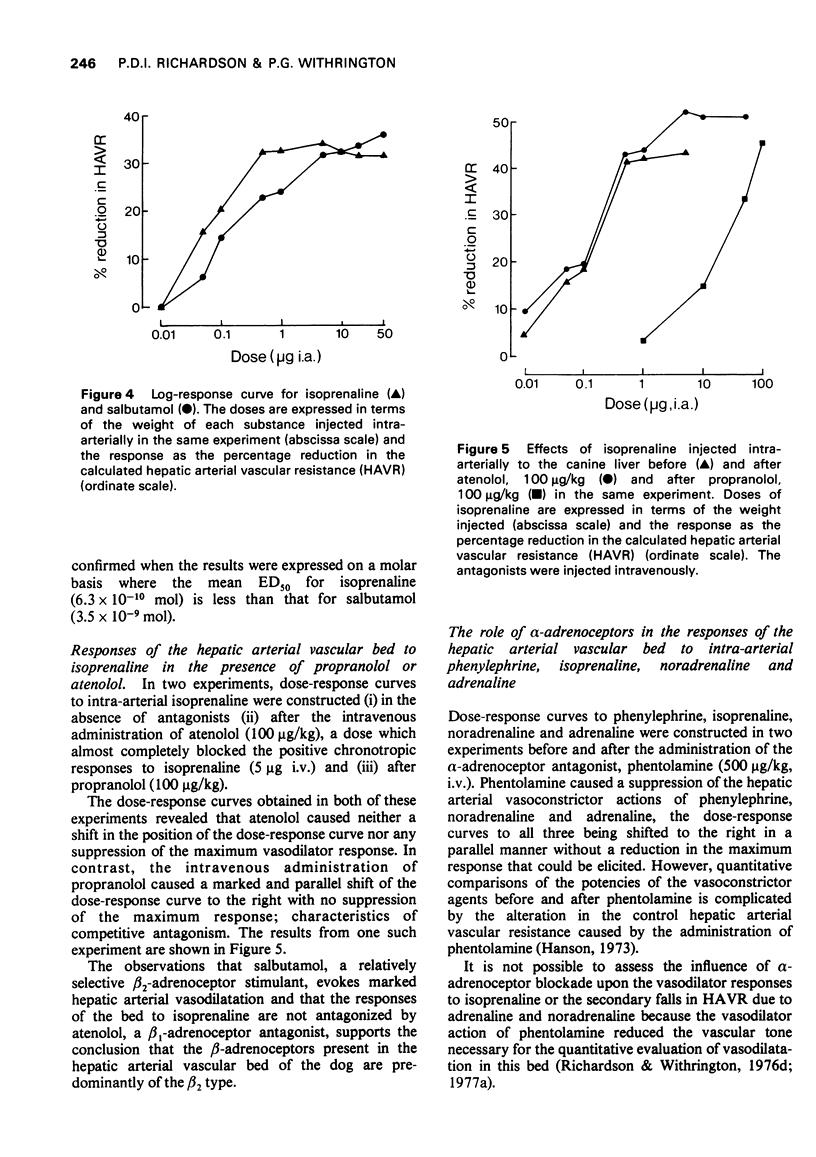
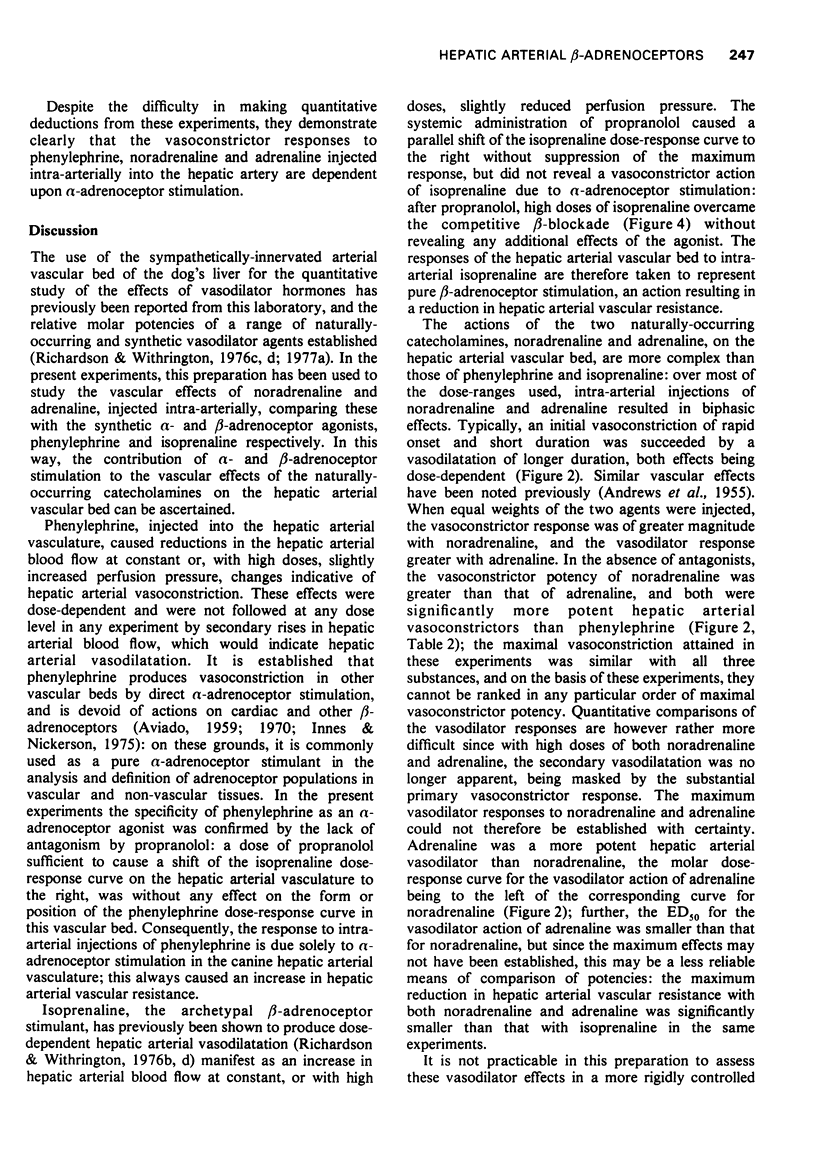
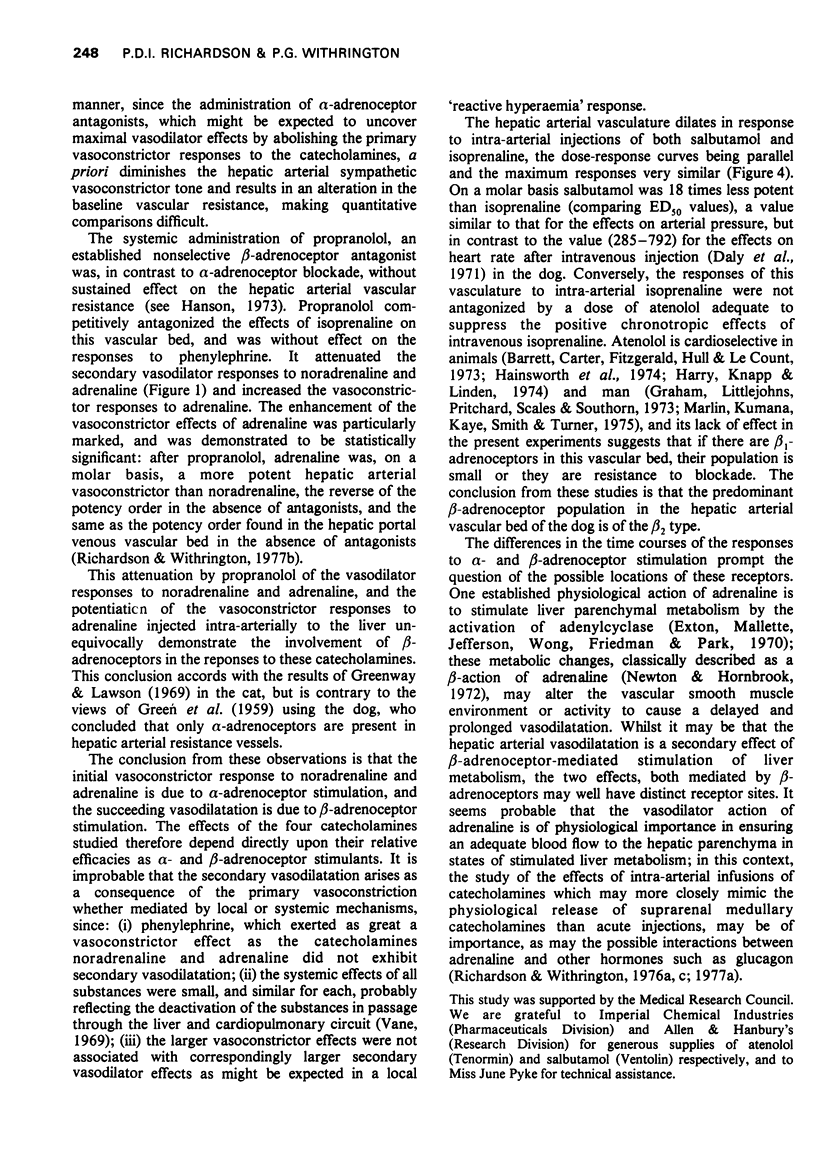
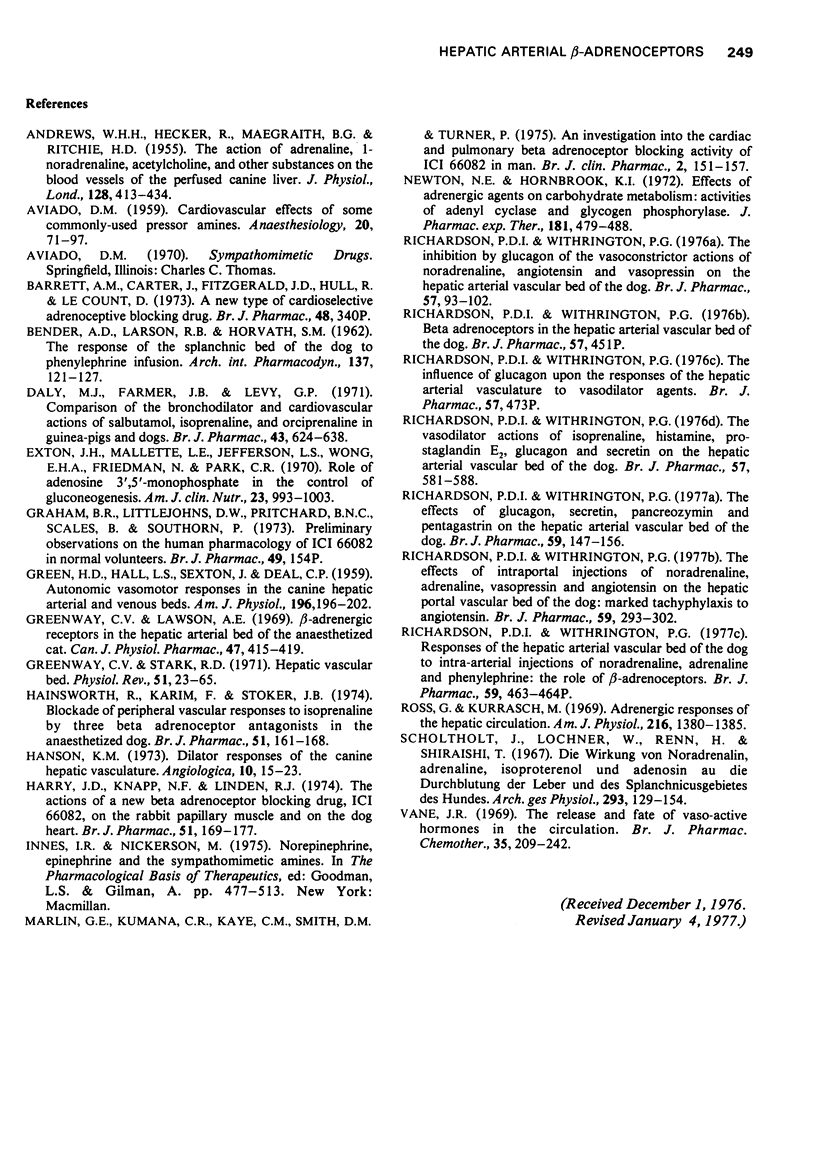
Selected References
These references are in PubMed. This may not be the complete list of references from this article.
- ANDREWS W. H. H., HECKER R., MAEGRAITH B. G., RITCHIE H. D. The action of adrenaline, L-noradrenaline, acetylcholine and other substances on the blood vessels of the perfused canine liver. J Physiol. 1955 Jun 28;128(3):413–434. doi: 10.1113/jphysiol.1955.sp005316. [DOI] [PMC free article] [PubMed] [Google Scholar]
- AVIADO D. M., Jr Cardiovascular effects of some commonly used pressor amines. Anesthesiology. 1959 Jan-Feb;20(1):71–97. doi: 10.1097/00000542-195901000-00012. [DOI] [PubMed] [Google Scholar]
- BENDER A. D., LARSEN R. B., HORVATH S. M. The response of the splanchnic bed of the dog to phenylephrine infusion. Arch Int Pharmacodyn Ther. 1962 May 1;137:121–127. [PubMed] [Google Scholar]
- Barrett A. M., Carter J., Fitzgerald J. D., Hull R., Le Count D. A new type of cardioselective adrenoceptive blocking drug. Br J Pharmacol. 1973 Jun;48(2):340P–340P. [PMC free article] [PubMed] [Google Scholar]
- Daly M. J., Farmer J. B., Levy G. P. Comparison of the bronchodilator and cardiovascular actions of salbutamol, isoprenaline and orciprenaline in guinea-pigs and dogs. Br J Pharmacol. 1971 Nov;43(3):624–638. doi: 10.1111/j.1476-5381.1971.tb07192.x. [DOI] [PMC free article] [PubMed] [Google Scholar]
- Exton J. H., Mallette L. E., Jefferson L. S., Wong E. H., Friedmann N., Park C. R. Role of adenosine 3',5'-monophosphate in the control of gluconeogenesis. Am J Clin Nutr. 1970 Jul;23(7):993–1003. doi: 10.1093/ajcn/23.7.993. [DOI] [PubMed] [Google Scholar]
- GREEN H. D., HALL L. S., SEXTON J., DEAL C. P. Autonomic vasomotor responses in the canine hepatic arterial and venous beds. Am J Physiol. 1959 Jan;196(1):196–202. doi: 10.1152/ajplegacy.1958.196.1.196. [DOI] [PubMed] [Google Scholar]
- Graham B. R., Littlejohns D. W., Prichard B. N., Scales B., Southorn P. Proceedings: Preliminary observations on the human pharmacology of I.C.I. 66082 in normal volunteers. Br J Pharmacol. 1973 Sep;49(1):154P–155P. [PMC free article] [PubMed] [Google Scholar]
- Greenway C. V., Lawson A. E. Beta-adrenergic receptors in the hepatic arterial bed of the anesthetized cat. Can J Physiol Pharmacol. 1969 May;47(5):415–419. doi: 10.1139/y69-075. [DOI] [PubMed] [Google Scholar]
- Greenway C. V., Stark R. D. Hepatic vascular bed. Physiol Rev. 1971 Jan;51(1):23–65. doi: 10.1152/physrev.1971.51.1.23. [DOI] [PubMed] [Google Scholar]
- Hainsworth R., Karim F., Stoker J. B. Blockade of peripheral vascular responses to isoprenaline by three beta-adrenoceptor antagonists in the anaesthetized dog. Br J Pharmacol. 1974 Jun;51(2):161–168. doi: 10.1111/j.1476-5381.1974.tb09643.x. [DOI] [PMC free article] [PubMed] [Google Scholar]
- Hanson K. M. Dilator responses of the canine hepatic vasculature. Angiologica. 1973;10(1):15–23. doi: 10.1159/000157956. [DOI] [PubMed] [Google Scholar]
- Harry J. D., Knapp M. F., Linden R. J. The actions of a new beta-adrenoceptor blocking drug, ICI 66082, on the rabbit papillary muscle and on the dog heart. Br J Pharmacol. 1974 Jun;51(2):169–177. doi: 10.1111/j.1476-5381.1974.tb09644.x. [DOI] [PMC free article] [PubMed] [Google Scholar]
- Marlin G. E., Kumana C. R., Kaye C. M., Smith D. M., Turner P. An investigation into the cardiac and pulmonary beta-adrenoceptor blocking activity of ICI 66,082 in man. Br J Clin Pharmacol. 1975 Apr;2(2):151–157. doi: 10.1111/j.1365-2125.1975.tb01570.x. [DOI] [PMC free article] [PubMed] [Google Scholar]
- Newton N. E., Hornbrook K. R. Effects of adrenergic agents on carbohydrate metabolism of rat liver: activities of adenyl cyclase and glycogen phosphorylase. J Pharmacol Exp Ther. 1972 Jun;181(3):479–488. [PubMed] [Google Scholar]
- Richardson P. D., Withrington P. G. Responses of the hepatic arterial vascular bed of the dog to intra-arterial injections of noradrenaline, adrenaline and phenylephrine: the role of beta-adrenoceptors [proceedings]. Br J Pharmacol. 1977 Mar;59(3):463P–464P. [PMC free article] [PubMed] [Google Scholar]
- Richardson P. D., Withrington P. G. The effects of glucagon, secretin, pancreozymin and pentagastrin on the hepatic arterial vascular bed of the dog. Br J Pharmacol. 1977 Jan;59(1):147–156. doi: 10.1111/j.1476-5381.1977.tb06989.x. [DOI] [PMC free article] [PubMed] [Google Scholar]
- Richardson P. D., Withrington P. G. The effects of intraportal injections of noradrenaline, adrenaline, vasopressin and angiotensin on the hepatic portal vascular bed of the dog: marked tachyphylaxis to angiotensin. Br J Pharmacol. 1977 Feb;59(2):293–301. doi: 10.1111/j.1476-5381.1977.tb07492.x. [DOI] [PMC free article] [PubMed] [Google Scholar]
- Richardson P. D., Withrington P. G. The influence of glucagon upon the responses of the hepatic arterial vasculature to vasodilator agents [proceedings]. Br J Pharmacol. 1976 Jul;57(3):473P–473P. [PMC free article] [PubMed] [Google Scholar]
- Richardson P. D., Withrington P. G. The inhibition by glucagon of the vasoconstrictor actions of noradrenaline, angiotensin and vasopressin on the hepatic arterial vascular bed of the dog. Br J Pharmacol. 1976 May;57(1):93–102. doi: 10.1111/j.1476-5381.1976.tb07659.x. [DOI] [PMC free article] [PubMed] [Google Scholar]
- Ross G., Kurrasch M. Adrenergic responses of the hepatic circulation. Am J Physiol. 1969 Jun;216(6):1380–1385. doi: 10.1152/ajplegacy.1969.216.6.1380. [DOI] [PubMed] [Google Scholar]
- Scholtholt J., Lochner W., Renn H., Shiraishi T. Die Wirkung von Noradrenalin, Adrenalin, Isoproterenol und Adenosin auf die Durchblutung der Leber und des Splanchnicusgebietes des Hundes. Pflugers Arch Gesamte Physiol Menschen Tiere. 1967;293(2):129–154. [PubMed] [Google Scholar]
- Vane J. R. The release and fate of vaso-active hormones in the circulation. Br J Pharmacol. 1969 Feb;35(2):209–242. doi: 10.1111/j.1476-5381.1969.tb07982.x. [DOI] [PMC free article] [PubMed] [Google Scholar]


